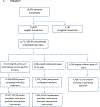Population-Based HIV Impact Assessments Survey Methods, Response, and Quality in Zimbabwe, Malawi, and Zambia
- PMID: 34166308
- PMCID: PMC8650710
- DOI: 10.1097/QAI.0000000000002710
Population-Based HIV Impact Assessments Survey Methods, Response, and Quality in Zimbabwe, Malawi, and Zambia
Abstract
Background: The population-based HIV impact assessment (population-based HIV impact assessments) surveys are among the first to estimate national adult HIV incidence, subnational prevalence of viral load suppression, and pediatric HIV prevalence. We summarize the survey methods implemented in Zimbabwe, Malawi, and Zambia, as well as response rates and quality metrics.
Methods: Each cross-sectional, household-based survey used a 2-stage cluster design. Survey preparations included sample design, questionnaire development, tablet programming for informed consent and data collection, community mobilization, establishing a network of satellite laboratories, and fieldworker training. Interviewers collected demographic, behavioral, and clinical information using tablets. Blood was collected for home-based HIV testing and counseling (HBTC) and point-of-care CD4+ T-cell enumeration with results immediately returned. HIV-positive blood samples underwent laboratory-based confirmatory testing, HIV incidence testing, RNA polymerase chain reaction (viral load), DNA polymerase chain reaction (early infant diagnosis), and serum antiretroviral drug detection. Data were weighted for survey design, and chi square automatic interaction detection-based methods were used to adjust for nonresponse.
Results: Each survey recruited a nationally representative, household-based sample of children and adults over a 6-10-month period in 2015 and 2016. Most (84%-90%) of the 12,000-14,000 eligible households in each country participated in the survey, with 77%-81% of eligible adults completing an interview and providing blood for HIV testing. Among eligible children, 59%-73% completed HIV testing. Across the 3 surveys, 97.8% of interview data were complete and had no errors.
Conclusion: Conducting a national population-based HIV impact assessment with immediate return of HIV and other point-of-care test results was feasible, and data quality was high.
Copyright © 2021 Wolters Kluwer Health, Inc. All rights reserved.
Conflict of interest statement
The authors have no conflicts of interest to disclose.
Figures





References
-
- UNAIDS. Global AIDS Update 2016. 2016.
-
- UNAIDS. Miles to Go: Closing Gaps Breaking Barriers Righting Injustices. 2018.
-
- UNAIDS. AIDSinfo. Available from: http://aidsinfo.unaids.org/. Accessed 11 June, 2019.
-
- UNAIDS. 90–90-90: An ambitious treatment target to help end the AIDS epidemic. 2014.
-
- Zimbabwe National Statistics Agency and ICF International, Zimbabwe Demographic and Health Survey 2015. Rockville, Maryland, USA. 2016.
Publication types
MeSH terms
Substances
Grants and funding
LinkOut - more resources
Full Text Sources
Medical
Research Materials

